Performance Management: Identifying and Addressing Errors Report
VerifiedAdded on 2022/08/27
|7
|1603
|19
Report
AI Summary
This report provides an in-depth analysis of performance management systems, specifically addressing the challenges of inaccurate ratings and their impact on employee satisfaction. The report highlights the importance of identifying and mitigating errors in rater programs, such as the halo effect and central tendency. It emphasizes the need for aligning employee goals with organizational objectives to enhance motivation and performance. The report also proposes the implementation of a rater training program, specifically the Frame-of-Reference (FOR) training, to improve the analytical skills of supervisors and reduce rating inaccuracies. The conclusion underscores the importance of effective performance management in achieving organizational goals and maintaining employee satisfaction.
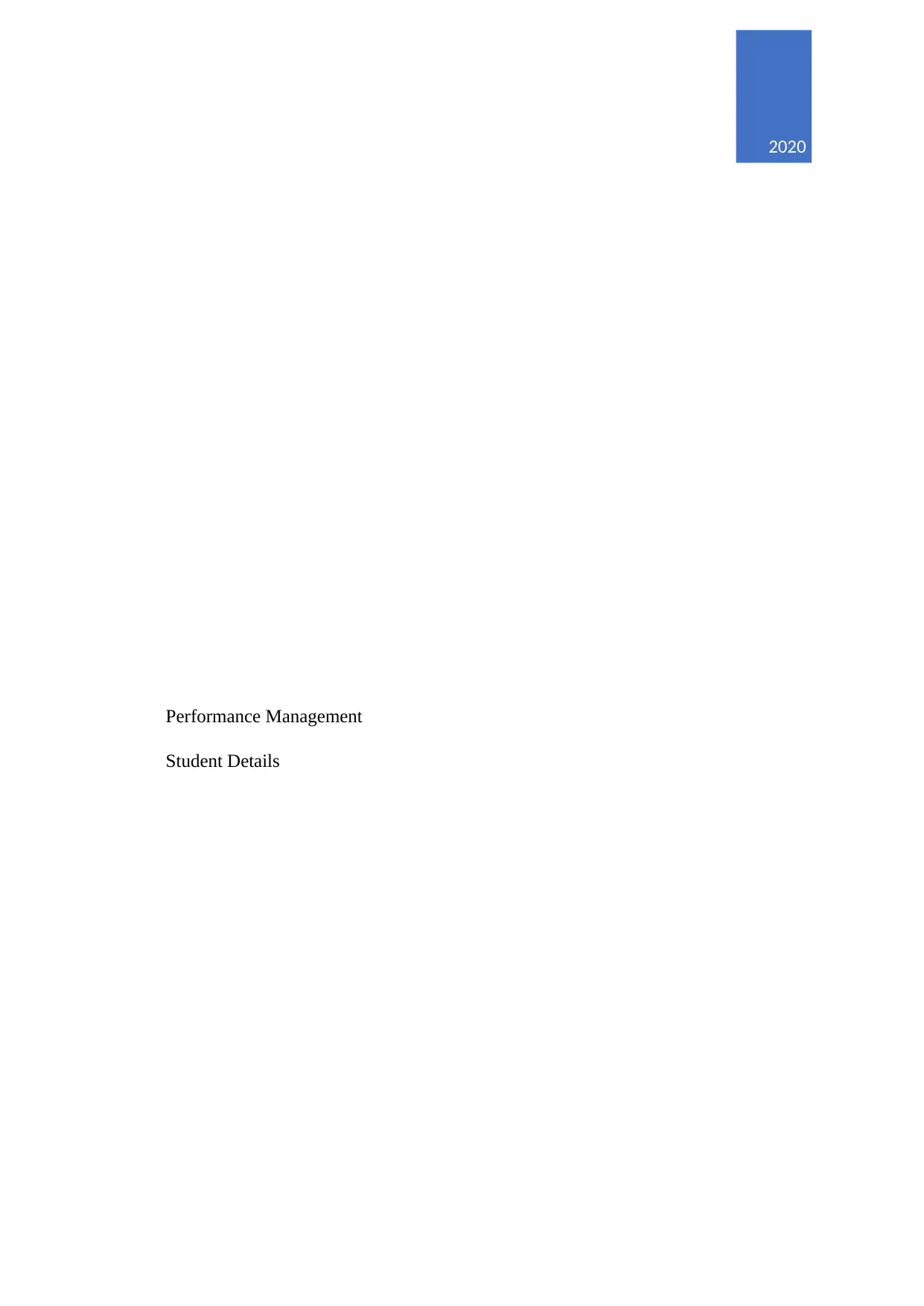
2020
Performance Management
Student Details
Performance Management
Student Details
Paraphrase This Document
Need a fresh take? Get an instant paraphrase of this document with our AI Paraphraser
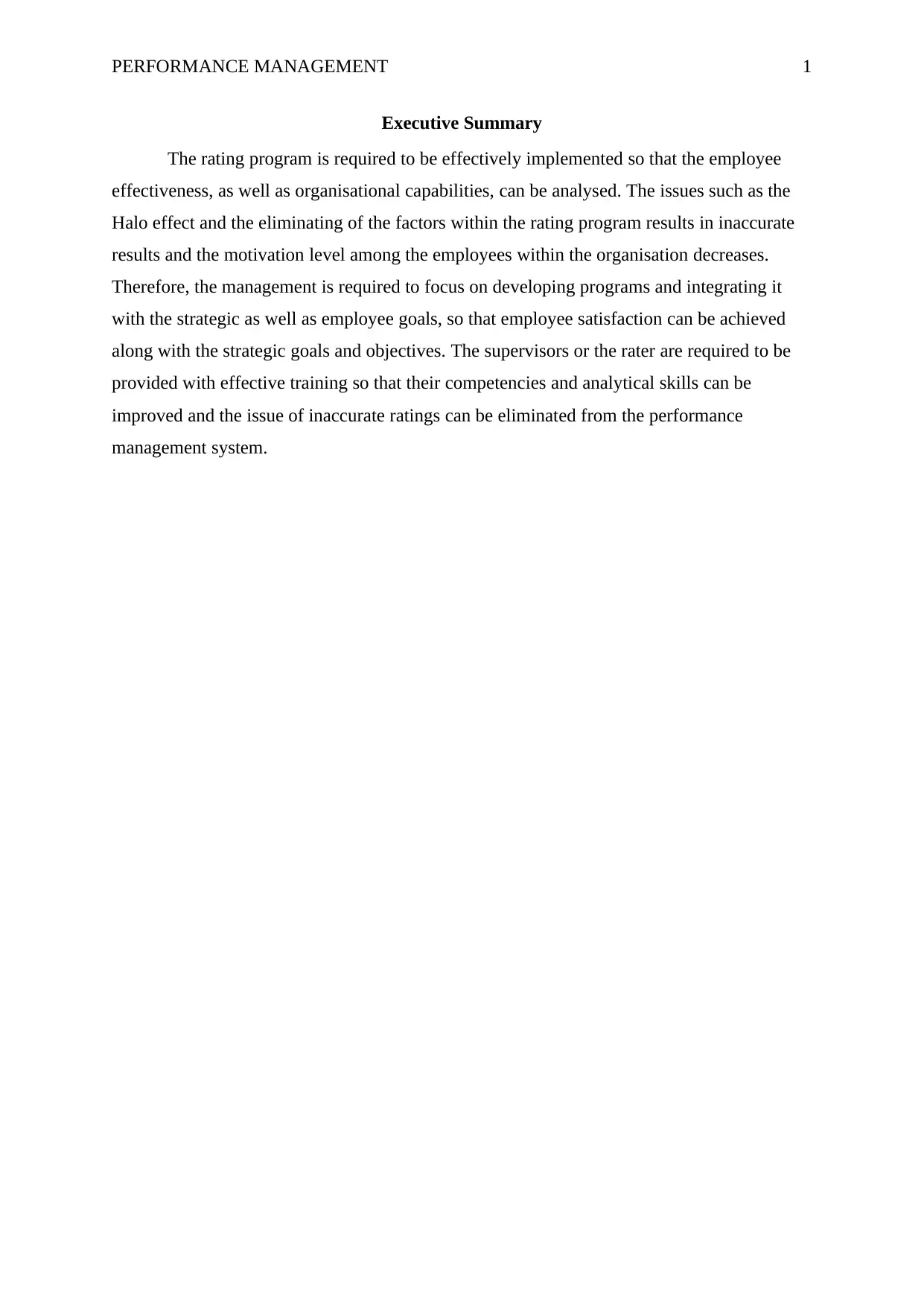
PERFORMANCE MANAGEMENT 1
Executive Summary
The rating program is required to be effectively implemented so that the employee
effectiveness, as well as organisational capabilities, can be analysed. The issues such as the
Halo effect and the eliminating of the factors within the rating program results in inaccurate
results and the motivation level among the employees within the organisation decreases.
Therefore, the management is required to focus on developing programs and integrating it
with the strategic as well as employee goals, so that employee satisfaction can be achieved
along with the strategic goals and objectives. The supervisors or the rater are required to be
provided with effective training so that their competencies and analytical skills can be
improved and the issue of inaccurate ratings can be eliminated from the performance
management system.
Executive Summary
The rating program is required to be effectively implemented so that the employee
effectiveness, as well as organisational capabilities, can be analysed. The issues such as the
Halo effect and the eliminating of the factors within the rating program results in inaccurate
results and the motivation level among the employees within the organisation decreases.
Therefore, the management is required to focus on developing programs and integrating it
with the strategic as well as employee goals, so that employee satisfaction can be achieved
along with the strategic goals and objectives. The supervisors or the rater are required to be
provided with effective training so that their competencies and analytical skills can be
improved and the issue of inaccurate ratings can be eliminated from the performance
management system.
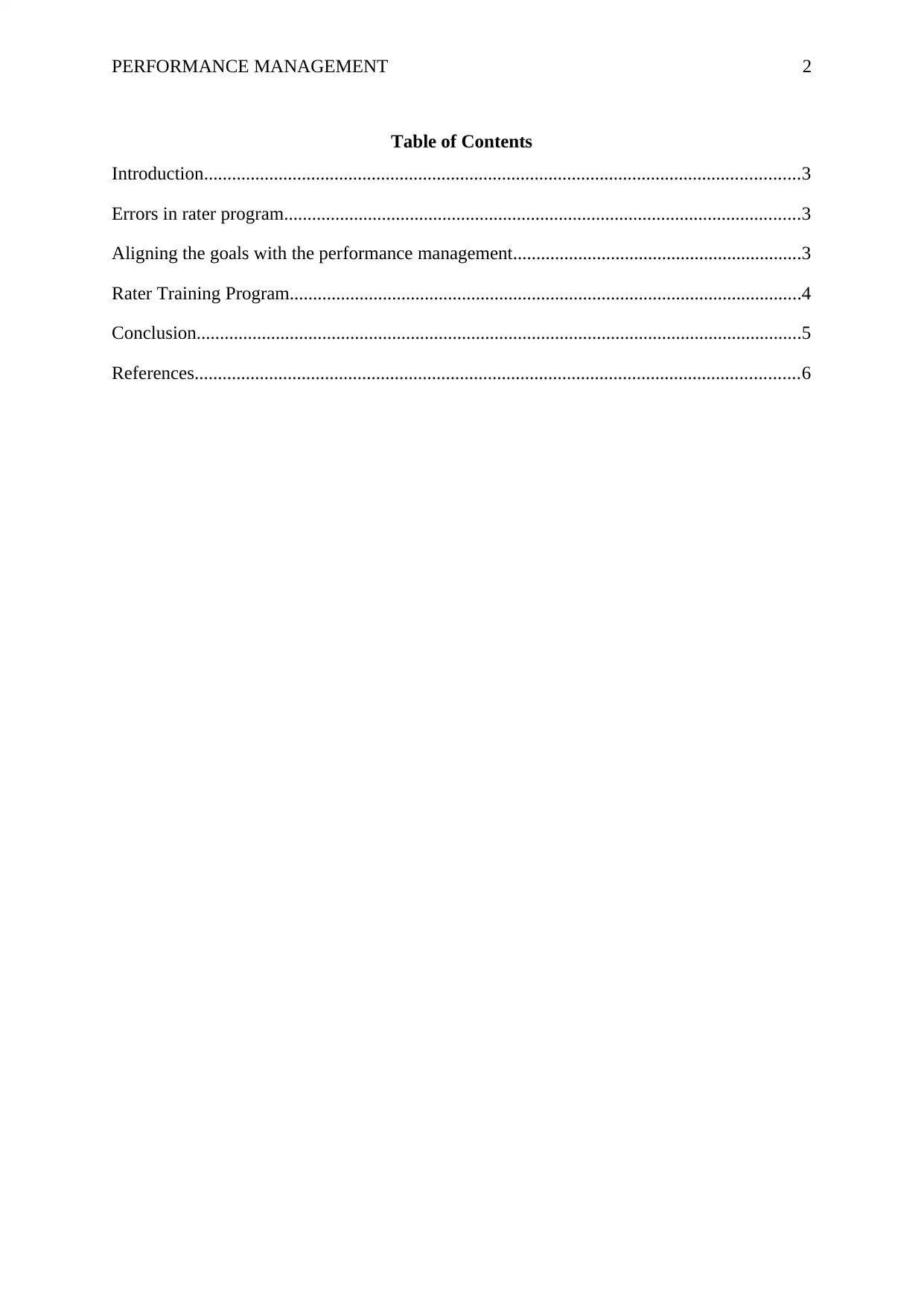
PERFORMANCE MANAGEMENT 2
Table of Contents
Introduction................................................................................................................................3
Errors in rater program...............................................................................................................3
Aligning the goals with the performance management..............................................................3
Rater Training Program..............................................................................................................4
Conclusion..................................................................................................................................5
References..................................................................................................................................6
Table of Contents
Introduction................................................................................................................................3
Errors in rater program...............................................................................................................3
Aligning the goals with the performance management..............................................................3
Rater Training Program..............................................................................................................4
Conclusion..................................................................................................................................5
References..................................................................................................................................6
⊘ This is a preview!⊘
Do you want full access?
Subscribe today to unlock all pages.

Trusted by 1+ million students worldwide
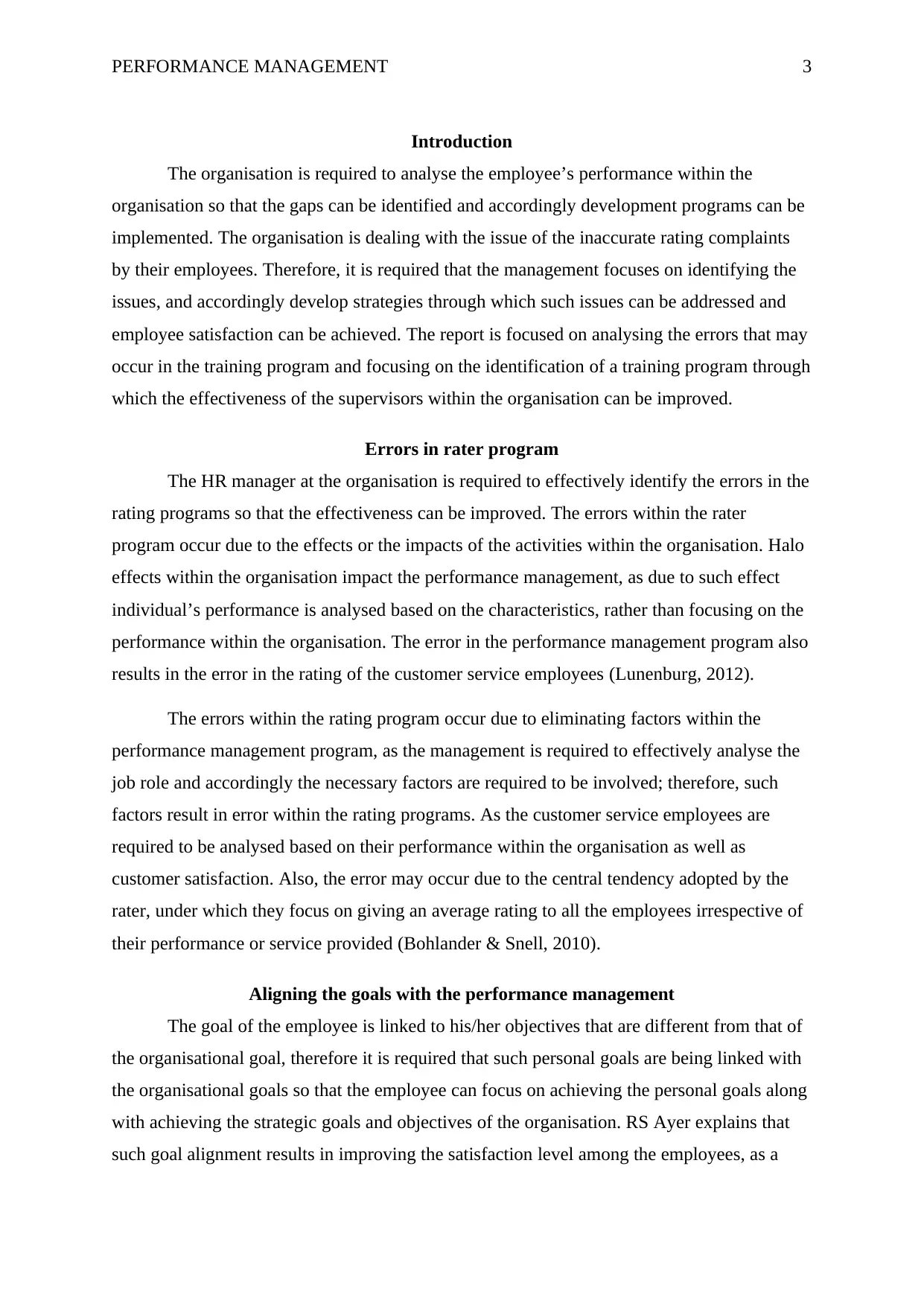
PERFORMANCE MANAGEMENT 3
Introduction
The organisation is required to analyse the employee’s performance within the
organisation so that the gaps can be identified and accordingly development programs can be
implemented. The organisation is dealing with the issue of the inaccurate rating complaints
by their employees. Therefore, it is required that the management focuses on identifying the
issues, and accordingly develop strategies through which such issues can be addressed and
employee satisfaction can be achieved. The report is focused on analysing the errors that may
occur in the training program and focusing on the identification of a training program through
which the effectiveness of the supervisors within the organisation can be improved.
Errors in rater program
The HR manager at the organisation is required to effectively identify the errors in the
rating programs so that the effectiveness can be improved. The errors within the rater
program occur due to the effects or the impacts of the activities within the organisation. Halo
effects within the organisation impact the performance management, as due to such effect
individual’s performance is analysed based on the characteristics, rather than focusing on the
performance within the organisation. The error in the performance management program also
results in the error in the rating of the customer service employees (Lunenburg, 2012).
The errors within the rating program occur due to eliminating factors within the
performance management program, as the management is required to effectively analyse the
job role and accordingly the necessary factors are required to be involved; therefore, such
factors result in error within the rating programs. As the customer service employees are
required to be analysed based on their performance within the organisation as well as
customer satisfaction. Also, the error may occur due to the central tendency adopted by the
rater, under which they focus on giving an average rating to all the employees irrespective of
their performance or service provided (Bohlander & Snell, 2010).
Aligning the goals with the performance management
The goal of the employee is linked to his/her objectives that are different from that of
the organisational goal, therefore it is required that such personal goals are being linked with
the organisational goals so that the employee can focus on achieving the personal goals along
with achieving the strategic goals and objectives of the organisation. RS Ayer explains that
such goal alignment results in improving the satisfaction level among the employees, as a
Introduction
The organisation is required to analyse the employee’s performance within the
organisation so that the gaps can be identified and accordingly development programs can be
implemented. The organisation is dealing with the issue of the inaccurate rating complaints
by their employees. Therefore, it is required that the management focuses on identifying the
issues, and accordingly develop strategies through which such issues can be addressed and
employee satisfaction can be achieved. The report is focused on analysing the errors that may
occur in the training program and focusing on the identification of a training program through
which the effectiveness of the supervisors within the organisation can be improved.
Errors in rater program
The HR manager at the organisation is required to effectively identify the errors in the
rating programs so that the effectiveness can be improved. The errors within the rater
program occur due to the effects or the impacts of the activities within the organisation. Halo
effects within the organisation impact the performance management, as due to such effect
individual’s performance is analysed based on the characteristics, rather than focusing on the
performance within the organisation. The error in the performance management program also
results in the error in the rating of the customer service employees (Lunenburg, 2012).
The errors within the rating program occur due to eliminating factors within the
performance management program, as the management is required to effectively analyse the
job role and accordingly the necessary factors are required to be involved; therefore, such
factors result in error within the rating programs. As the customer service employees are
required to be analysed based on their performance within the organisation as well as
customer satisfaction. Also, the error may occur due to the central tendency adopted by the
rater, under which they focus on giving an average rating to all the employees irrespective of
their performance or service provided (Bohlander & Snell, 2010).
Aligning the goals with the performance management
The goal of the employee is linked to his/her objectives that are different from that of
the organisational goal, therefore it is required that such personal goals are being linked with
the organisational goals so that the employee can focus on achieving the personal goals along
with achieving the strategic goals and objectives of the organisation. RS Ayer explains that
such goal alignment results in improving the satisfaction level among the employees, as a
Paraphrase This Document
Need a fresh take? Get an instant paraphrase of this document with our AI Paraphraser
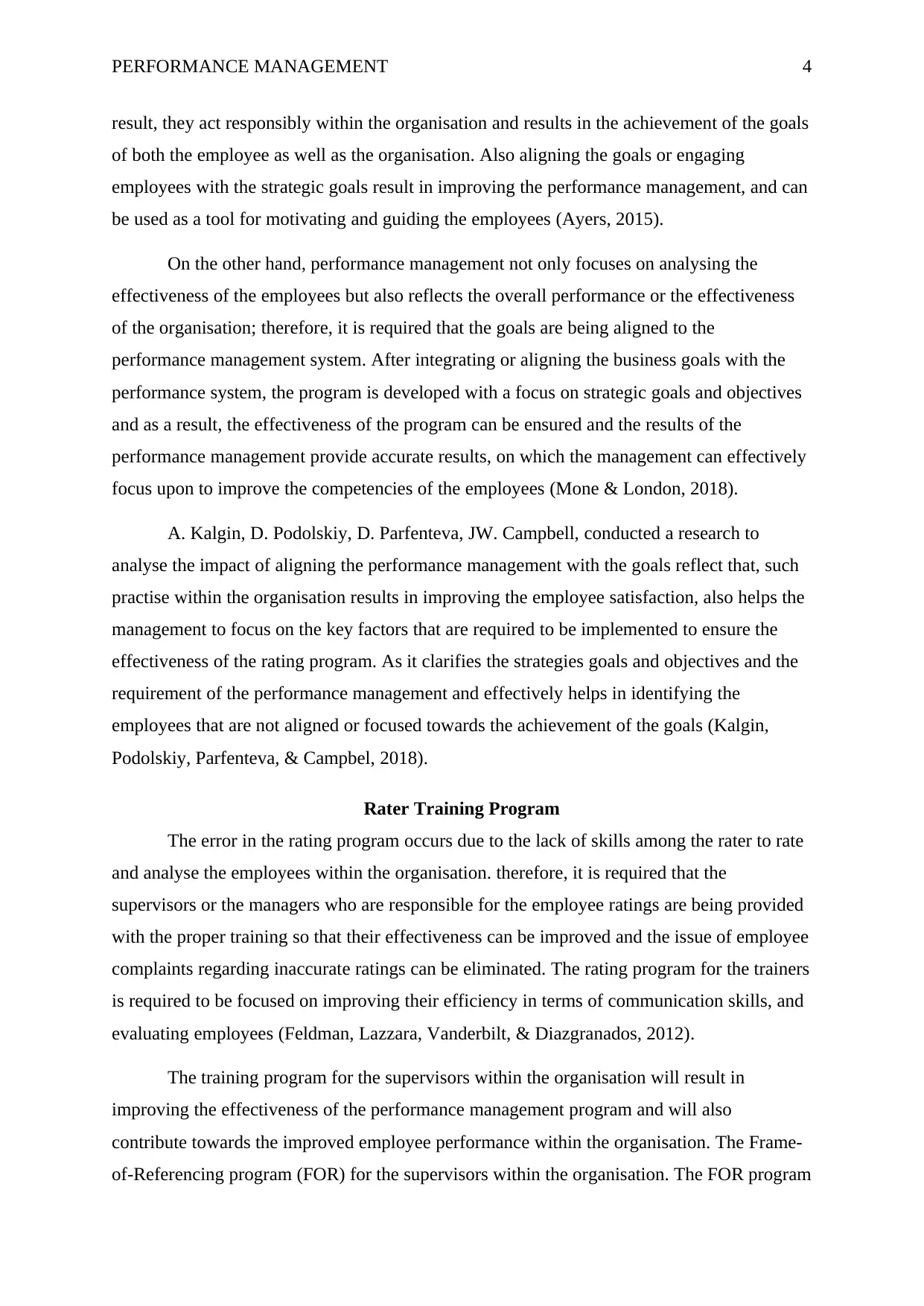
PERFORMANCE MANAGEMENT 4
result, they act responsibly within the organisation and results in the achievement of the goals
of both the employee as well as the organisation. Also aligning the goals or engaging
employees with the strategic goals result in improving the performance management, and can
be used as a tool for motivating and guiding the employees (Ayers, 2015).
On the other hand, performance management not only focuses on analysing the
effectiveness of the employees but also reflects the overall performance or the effectiveness
of the organisation; therefore, it is required that the goals are being aligned to the
performance management system. After integrating or aligning the business goals with the
performance system, the program is developed with a focus on strategic goals and objectives
and as a result, the effectiveness of the program can be ensured and the results of the
performance management provide accurate results, on which the management can effectively
focus upon to improve the competencies of the employees (Mone & London, 2018).
A. Kalgin, D. Podolskiy, D. Parfenteva, JW. Campbell, conducted a research to
analyse the impact of aligning the performance management with the goals reflect that, such
practise within the organisation results in improving the employee satisfaction, also helps the
management to focus on the key factors that are required to be implemented to ensure the
effectiveness of the rating program. As it clarifies the strategies goals and objectives and the
requirement of the performance management and effectively helps in identifying the
employees that are not aligned or focused towards the achievement of the goals (Kalgin,
Podolskiy, Parfenteva, & Campbel, 2018).
Rater Training Program
The error in the rating program occurs due to the lack of skills among the rater to rate
and analyse the employees within the organisation. therefore, it is required that the
supervisors or the managers who are responsible for the employee ratings are being provided
with the proper training so that their effectiveness can be improved and the issue of employee
complaints regarding inaccurate ratings can be eliminated. The rating program for the trainers
is required to be focused on improving their efficiency in terms of communication skills, and
evaluating employees (Feldman, Lazzara, Vanderbilt, & Diazgranados, 2012).
The training program for the supervisors within the organisation will result in
improving the effectiveness of the performance management program and will also
contribute towards the improved employee performance within the organisation. The Frame-
of-Referencing program (FOR) for the supervisors within the organisation. The FOR program
result, they act responsibly within the organisation and results in the achievement of the goals
of both the employee as well as the organisation. Also aligning the goals or engaging
employees with the strategic goals result in improving the performance management, and can
be used as a tool for motivating and guiding the employees (Ayers, 2015).
On the other hand, performance management not only focuses on analysing the
effectiveness of the employees but also reflects the overall performance or the effectiveness
of the organisation; therefore, it is required that the goals are being aligned to the
performance management system. After integrating or aligning the business goals with the
performance system, the program is developed with a focus on strategic goals and objectives
and as a result, the effectiveness of the program can be ensured and the results of the
performance management provide accurate results, on which the management can effectively
focus upon to improve the competencies of the employees (Mone & London, 2018).
A. Kalgin, D. Podolskiy, D. Parfenteva, JW. Campbell, conducted a research to
analyse the impact of aligning the performance management with the goals reflect that, such
practise within the organisation results in improving the employee satisfaction, also helps the
management to focus on the key factors that are required to be implemented to ensure the
effectiveness of the rating program. As it clarifies the strategies goals and objectives and the
requirement of the performance management and effectively helps in identifying the
employees that are not aligned or focused towards the achievement of the goals (Kalgin,
Podolskiy, Parfenteva, & Campbel, 2018).
Rater Training Program
The error in the rating program occurs due to the lack of skills among the rater to rate
and analyse the employees within the organisation. therefore, it is required that the
supervisors or the managers who are responsible for the employee ratings are being provided
with the proper training so that their effectiveness can be improved and the issue of employee
complaints regarding inaccurate ratings can be eliminated. The rating program for the trainers
is required to be focused on improving their efficiency in terms of communication skills, and
evaluating employees (Feldman, Lazzara, Vanderbilt, & Diazgranados, 2012).
The training program for the supervisors within the organisation will result in
improving the effectiveness of the performance management program and will also
contribute towards the improved employee performance within the organisation. The Frame-
of-Referencing program (FOR) for the supervisors within the organisation. The FOR program
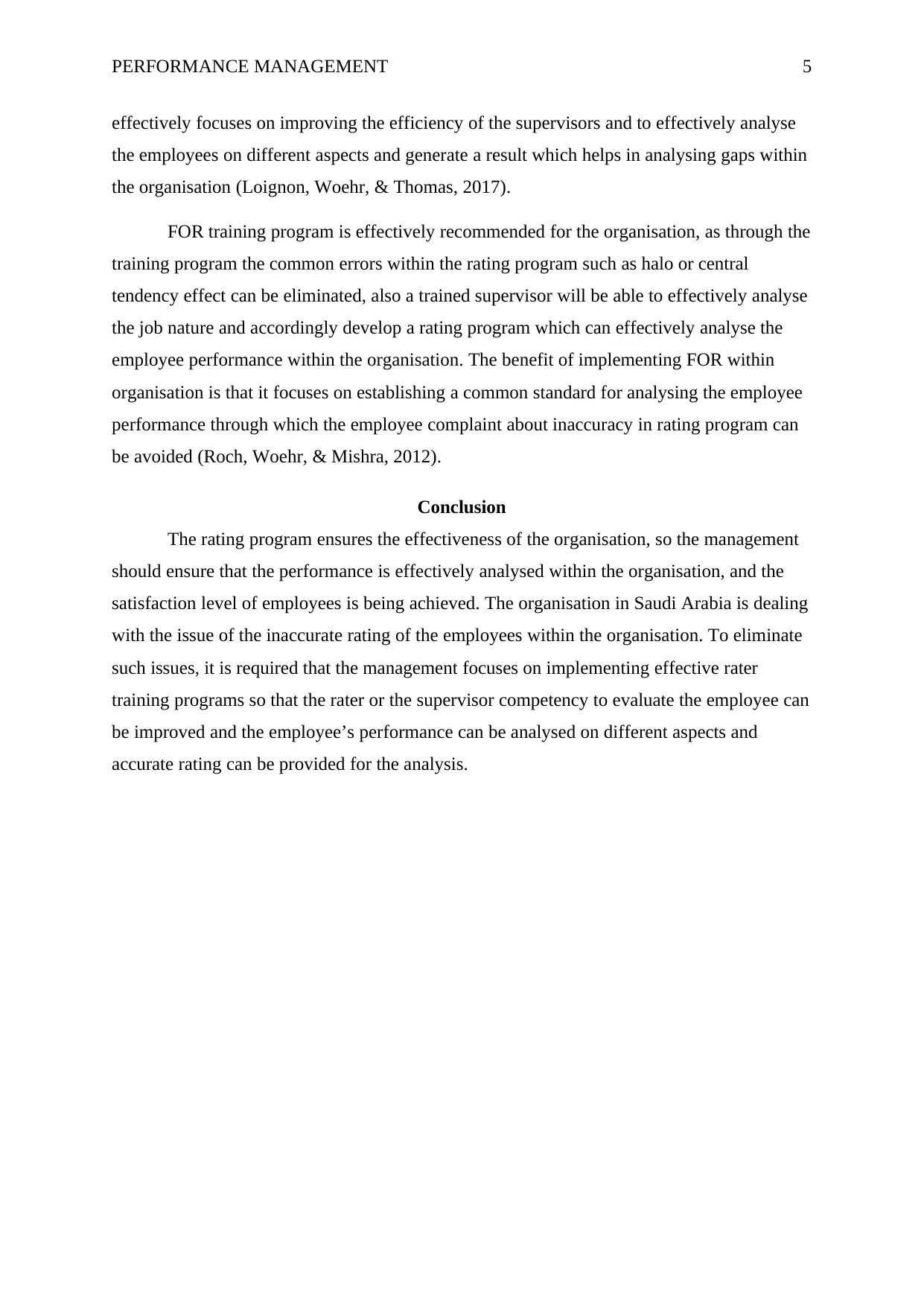
PERFORMANCE MANAGEMENT 5
effectively focuses on improving the efficiency of the supervisors and to effectively analyse
the employees on different aspects and generate a result which helps in analysing gaps within
the organisation (Loignon, Woehr, & Thomas, 2017).
FOR training program is effectively recommended for the organisation, as through the
training program the common errors within the rating program such as halo or central
tendency effect can be eliminated, also a trained supervisor will be able to effectively analyse
the job nature and accordingly develop a rating program which can effectively analyse the
employee performance within the organisation. The benefit of implementing FOR within
organisation is that it focuses on establishing a common standard for analysing the employee
performance through which the employee complaint about inaccuracy in rating program can
be avoided (Roch, Woehr, & Mishra, 2012).
Conclusion
The rating program ensures the effectiveness of the organisation, so the management
should ensure that the performance is effectively analysed within the organisation, and the
satisfaction level of employees is being achieved. The organisation in Saudi Arabia is dealing
with the issue of the inaccurate rating of the employees within the organisation. To eliminate
such issues, it is required that the management focuses on implementing effective rater
training programs so that the rater or the supervisor competency to evaluate the employee can
be improved and the employee’s performance can be analysed on different aspects and
accurate rating can be provided for the analysis.
effectively focuses on improving the efficiency of the supervisors and to effectively analyse
the employees on different aspects and generate a result which helps in analysing gaps within
the organisation (Loignon, Woehr, & Thomas, 2017).
FOR training program is effectively recommended for the organisation, as through the
training program the common errors within the rating program such as halo or central
tendency effect can be eliminated, also a trained supervisor will be able to effectively analyse
the job nature and accordingly develop a rating program which can effectively analyse the
employee performance within the organisation. The benefit of implementing FOR within
organisation is that it focuses on establishing a common standard for analysing the employee
performance through which the employee complaint about inaccuracy in rating program can
be avoided (Roch, Woehr, & Mishra, 2012).
Conclusion
The rating program ensures the effectiveness of the organisation, so the management
should ensure that the performance is effectively analysed within the organisation, and the
satisfaction level of employees is being achieved. The organisation in Saudi Arabia is dealing
with the issue of the inaccurate rating of the employees within the organisation. To eliminate
such issues, it is required that the management focuses on implementing effective rater
training programs so that the rater or the supervisor competency to evaluate the employee can
be improved and the employee’s performance can be analysed on different aspects and
accurate rating can be provided for the analysis.
⊘ This is a preview!⊘
Do you want full access?
Subscribe today to unlock all pages.

Trusted by 1+ million students worldwide
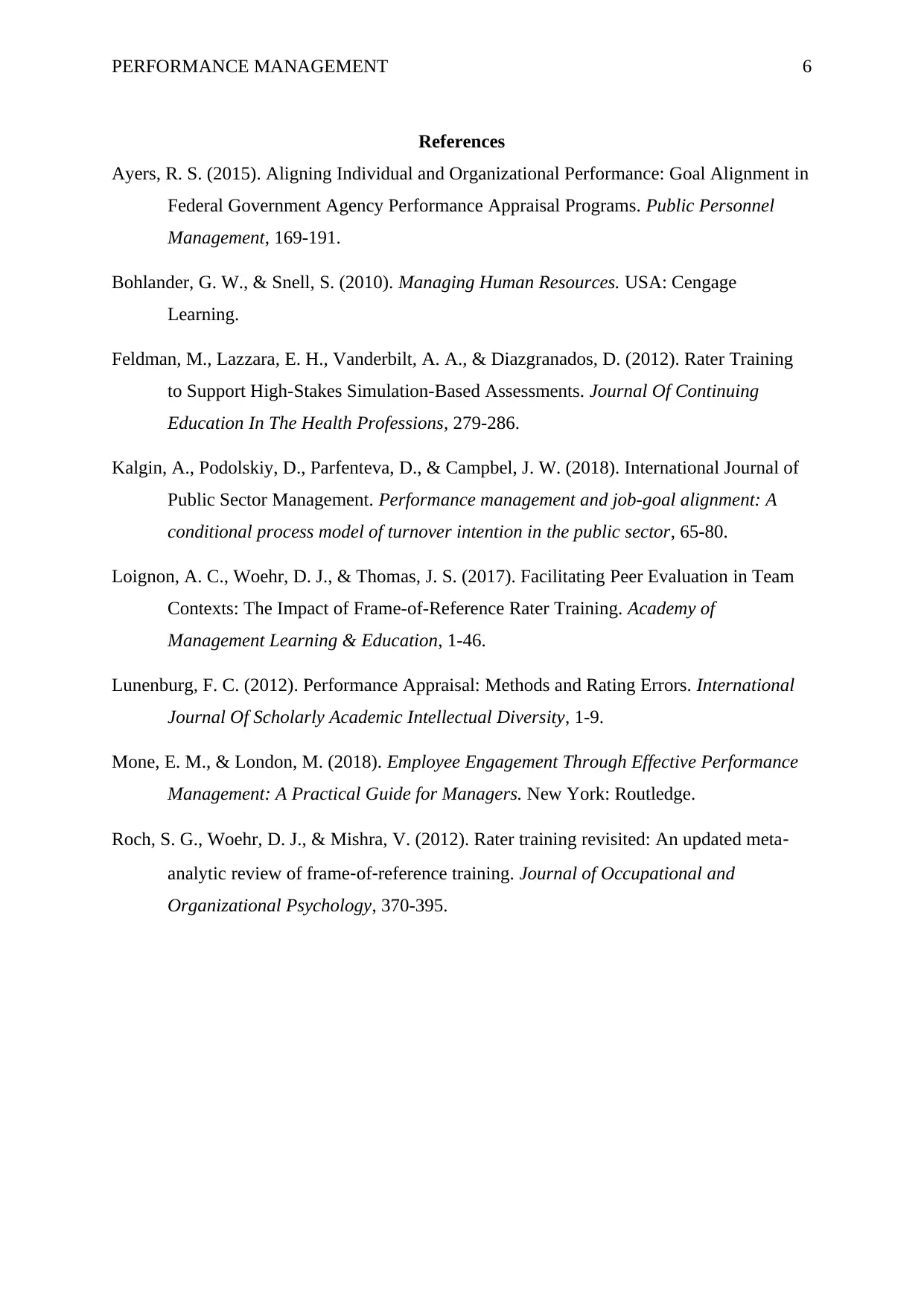
PERFORMANCE MANAGEMENT 6
References
Ayers, R. S. (2015). Aligning Individual and Organizational Performance: Goal Alignment in
Federal Government Agency Performance Appraisal Programs. Public Personnel
Management, 169-191.
Bohlander, G. W., & Snell, S. (2010). Managing Human Resources. USA: Cengage
Learning.
Feldman, M., Lazzara, E. H., Vanderbilt, A. A., & Diazgranados, D. (2012). Rater Training
to Support High-Stakes Simulation-Based Assessments. Journal Of Continuing
Education In The Health Professions, 279-286.
Kalgin, A., Podolskiy, D., Parfenteva, D., & Campbel, J. W. (2018). International Journal of
Public Sector Management. Performance management and job-goal alignment: A
conditional process model of turnover intention in the public sector, 65-80.
Loignon, A. C., Woehr, D. J., & Thomas, J. S. (2017). Facilitating Peer Evaluation in Team
Contexts: The Impact of Frame-of-Reference Rater Training. Academy of
Management Learning & Education, 1-46.
Lunenburg, F. C. (2012). Performance Appraisal: Methods and Rating Errors. International
Journal Of Scholarly Academic Intellectual Diversity, 1-9.
Mone, E. M., & London, M. (2018). Employee Engagement Through Effective Performance
Management: A Practical Guide for Managers. New York: Routledge.
Roch, S. G., Woehr, D. J., & Mishra, V. (2012). Rater training revisited: An updated meta‐
analytic review of frame‐of‐reference training. Journal of Occupational and
Organizational Psychology, 370-395.
References
Ayers, R. S. (2015). Aligning Individual and Organizational Performance: Goal Alignment in
Federal Government Agency Performance Appraisal Programs. Public Personnel
Management, 169-191.
Bohlander, G. W., & Snell, S. (2010). Managing Human Resources. USA: Cengage
Learning.
Feldman, M., Lazzara, E. H., Vanderbilt, A. A., & Diazgranados, D. (2012). Rater Training
to Support High-Stakes Simulation-Based Assessments. Journal Of Continuing
Education In The Health Professions, 279-286.
Kalgin, A., Podolskiy, D., Parfenteva, D., & Campbel, J. W. (2018). International Journal of
Public Sector Management. Performance management and job-goal alignment: A
conditional process model of turnover intention in the public sector, 65-80.
Loignon, A. C., Woehr, D. J., & Thomas, J. S. (2017). Facilitating Peer Evaluation in Team
Contexts: The Impact of Frame-of-Reference Rater Training. Academy of
Management Learning & Education, 1-46.
Lunenburg, F. C. (2012). Performance Appraisal: Methods and Rating Errors. International
Journal Of Scholarly Academic Intellectual Diversity, 1-9.
Mone, E. M., & London, M. (2018). Employee Engagement Through Effective Performance
Management: A Practical Guide for Managers. New York: Routledge.
Roch, S. G., Woehr, D. J., & Mishra, V. (2012). Rater training revisited: An updated meta‐
analytic review of frame‐of‐reference training. Journal of Occupational and
Organizational Psychology, 370-395.
1 out of 7
Related Documents
Your All-in-One AI-Powered Toolkit for Academic Success.
+13062052269
info@desklib.com
Available 24*7 on WhatsApp / Email
![[object Object]](/_next/static/media/star-bottom.7253800d.svg)
Unlock your academic potential
Copyright © 2020–2025 A2Z Services. All Rights Reserved. Developed and managed by ZUCOL.





